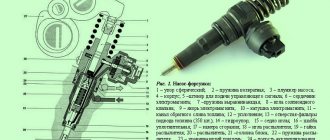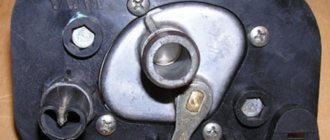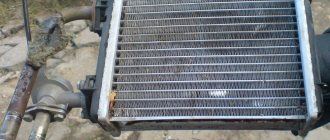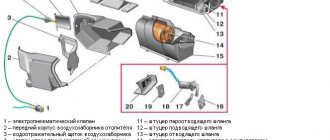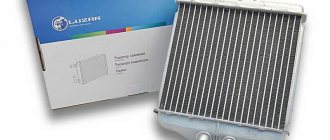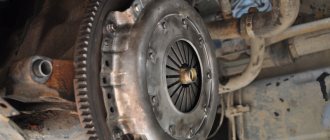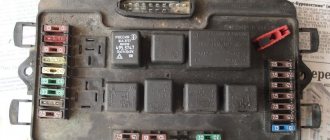There would be no question of any comfort while traveling in a VAZ-21099 car if the interior of this sedan were not equipped with a heating system. Moreover, ensuring a comfortable temperature in the cabin can be considered a secondary task, and the main one is heating the glass (windshield and side front doors) to ensure visibility in conditions of reduced temperatures.
The VAZ-21099 uses a heating system that is classic for all cars, in which the air is heated using an additional radiator of the cooling system installed in the cabin under the dashboard. Thanks to this location, it is possible to provide heating for several zones - airflow onto the windshields and side windows, under the feet and directly into the cabin itself. To ensure the efficiency of the stove, it is necessary that the flow movement is not spontaneous (due to temperature changes), but forced. And for this purpose, the heating system is additionally equipped with an electric fan.
Operating principle of the furnace system
As soon as the temperature outside the window drops below zero degrees, coolant in the car begins to flow directly through the furnace tap. After the engine warms up to the optimal temperature (about ninety degrees), antifreeze will begin to flow into the radiator.
Inside the car there is a special lever on the panel that is responsible for turning on the ventilation system. In the VAZ 21099 it is equipped with three power modes. You can also select the direction of the air flow. The air is directed using shock absorbers located at different points in the car.
Stove design
Stove structure: 1 – elastic bushing; 2 – spring nut; 3 – left fan casing; 4 – electric motor; 5 – impeller; 6 – right fan casing; 7 – windshield heating flap; 8 – damper for the foot airflow channel; 9 – heater control damper; 10 – right heater casing; 11 – bracket for fastening the heater casings; 12 – gasket; 13 – radiator; 14 – clamp; 15 – supply hose; 16 – outlet hose; 17 – tap; 18 – left heater casing; 19 – sealing cover; 20 – resistor; 21 – support for the heater control damper axis.
Structurally, the VAZ 2109 stove consists of several parts:
- The outer casing is made of several complex configurations of plastic parts that fit tightly together and have seals.
- Air ducts are large-diameter corrugated tubes through which air is delivered to the nozzles in the cabin (at the windshield, on the driver and passenger sides). The amount of flow is regulated by valves.
- Control valves - they are located both inside the dashboard and on it. The former are adjusted through traction cables, and the latter directly manually.
- The radiator is made of aluminum and plastic. Tubes and plates are metal. Plastic - storage tank.
- Fan - runs on electricity and is powered from the on-board network (12 V)
- Rubber tubes - connect the expansion tank, radiator, pump. Coolant is supplied and discharged through them.
- The pump is also electric, pumps antifreeze and provides more intense heat exchange.
- Thermal sensor - installed inside the radiator and controls the operation of the pump and fan.
- The tap is controlled by a special lever and allows you to completely shut off the coolant flow in the system.
- Control levers and rod system - displayed on the dashboard and transmit influence to internal dampers and switches
- The vernier for turning on and adjusting the fan speed is also located on the front panel next to the levers.
- Electrical unit - power wiring and loading resistors.
Part of the system that provides interior heating includes an expansion tank with antifreeze. It is into this that the antifreeze that has released heat from the radiator enters.
Important! A VAZ 2109 may have a high or low panel, when the stove does not heat well, its repair is identical in both cases.
Description
HEATER RADIATOR 2108 (SOLDERED COMFORT)
CODE LUZAR LRh 0108b
OEM NUMBER: 2108-8101060 2108-8101060-51P
CONSTRUCTION: COMFORT, aluminum non-assembled (brazed) tubular-tape
Heater radiators
Brand name – LRh – Luzar Radiator heater
Heating radiators (also known as heater radiators, also known as heater radiators) are heat exchangers that use the heat generated by the engine to heat the vehicle interior. They allow you to maintain a comfortable temperature and prevent the car windows from fogging up.
For reference: different names of this node have equal rights of use. For example, “heating radiator” and “stove” come from the function of this heat exchanger, “heater radiator” and “stove radiator” - from the installation location.
LUZAR manufactures hundreds of heater radiators for a wide range of cars presented on the Russian market. They can be purchased in partner stores throughout Russia or online.
Many models of heater radiators are supplied to car factories in Russia and Ukraine - both for passenger cars and for trucks and buses.
The production range of manufactured stoves is constantly increasing; New types are being developed for the most popular cars in Russia.
Powerful R&D allows us to conduct research in the field of improving heat exchangers and create new designs that provide increased performance properties of heater radiators. Main areas of research:
- use of different types of tubes
- changing the location of the tubes
- change in the “fillability” of the core
- use of turbulators-swirlers
- use of various aluminum alloys
- testing of solders with different characteristics
- improving the corrosion properties of metal
- ... and many other R&D areas.
Design of heating radiators from LUZAR
LUZAR heating radiators are available in three types:
- Tubular-plate, prefabricated, aluminum. It consists of aluminum plates through which aluminum tubes pass, inside which coolant runs. The tanks on such radiators are made of plastic. Heater radiators of this type are used for heating small-sized salons due to limited heat transfer; have the best rigidity and light weight, as well as the lowest price.
- Tubular-tape, non-assembled (brazed), aluminum. The corrugated aluminum tape in such a radiator is located between aluminum flat-oval tubes. Radiator tanks of this type can be made of either plastic or metal. The design of non-assembled (brazed) aluminum devices is the most universal, allowing the creation of heat exchangers with any specified characteristics. Aluminum stove radiators are lightweight and relatively high rigidity, as well as optimal prices.
- Tubular-tape, non-assembled (soldered), copper-brass. The design is very close to type 2 - between the copper flat-oval tubes there are copper strips folded in the form of an “accordion”. At the same time, the tanks on such heating radiators are made of brass - in order to increase the overall rigidity of the structure. Copper heating radiators - due to the high specific heat capacity of copper - have excellent heat transfer rates. However, due to the high softness of copper, heating radiators made of this metal are forced to have a narrow tube and a large interval (step) between the tubes, which imposes serious limitations on maximum efficiency. Also, copper heater radiators have the highest cost and the lowest rigidity to torsion, fracture and internal pressure. In this regard, copper heater radiators are “outdated” and are gradually falling out of use.
LUZAR: TESTED BY TIME AND ROADS
LUZAR radiators have been awarded the “Radiator of the Year” award several times
Features of the heater on the VAZ-2109
The stove on a VAZ is an ordinary heat exchanger. The heating system is connected to the engine cooling system through a heater valve. When the stove starts, this unit opens and antifreeze enters the radiator of the heating system.
Coolant temperature under normal conditions ranges from 70 to 90 degrees.
As the antifreeze circulates through the radiator pipes, it cools, which leads to the release of heat.
An important component of the heating system on the “nine” is the fan, which operates in one of three modes. This element directs the heated air mass into the nozzles, and the driver regulates the flow distribution using deflectors. In exactly the same way, air enters the car windows.
Main stove malfunctions
As we have already mentioned, the stove is connected to the internal combustion engine cooling system. Accordingly, heating problems may arise for the following reasons:
- Insufficient amount of coolant in the system.
- Clogging of radiator tubes.
- There are air pockets in the system. To eliminate them, you will need to unscrew the cap of the radiator or expansion tank and let the engine idle for a while.
There are a number of cooling system malfunctions that can also affect the performance of the VAZ-2109 heating system. We look at the most common ones.
The weak point of the heating system is the valve through which antifreeze enters the heater radiator. This unit may leak. In this case, it must be replaced with a new one.
Poor quality coolant causes damage to rubber pipes due to its aggressive chemical composition.
Check the condition of the pump, which is responsible for pumping antifreeze and circulating it in the cooling system.
Poor operation of the stove can be caused by incorrect operation of the electric motor that drives the heating system fan.
If you notice extraneous sounds in the operation of this motor, this is a signal for a number of problems:
- Possible overheating due to fuse failure.
- When operating at low speeds, warm air does not flow - the electric motor has failed or there has been a break in the electrical circuit of the heating system.
Replacement instructions
In most cases, the reason lies precisely in the radiator device, so below we will talk about how to replace the VAZ 2109 heater radiator.
How to change the unit on cars with a high or low panel, read on:
- The device itself is located at the passenger’s feet, under the glove compartment. The replacement procedure will be identical for cars with a high and low panel, only in the first case you will have to remove the passenger seat. After removing the chair, you can see the screws on the right that secure the panel; they need to be unscrewed. The panel itself needs to be slightly pulled towards itself; insert some kind of spacer, for example, a wooden beam, into the gap that appears.
- Fully tighten the tap, and place a rag under possible coolant leaks.
- Then open the engine compartment and unscrew the cap on the radiator unit. The last unit is located between the glove box, as well as the lower shelf below it. The steps you need to follow next must be completed as quickly as possible, otherwise the coolant may spill. The lines that come from the radiator device must be closed; this will require plugs. Reach your hand through the detached center console, disconnect the lower line and plug the hole with a plug as quickly as possible.
- Repeat similar steps with the upper hose.
- The radiator is removed after all consumables have been drained. A new device is being installed.
Some car owners believe that if the backlight on the center console in the heater area disappears, this is due to the operation of the stove. Remember that the backlight of the stove has nothing to do with the operation of the unit as a whole, so if the backlight has disappeared, you need to find an open circuit and repair it.
Sorry, there are no surveys available at this time.
It is no secret that its service life and reliability of operation largely depend on how an item is handled. This is perfect for a car heater. The more correctly you operate it, the better and longer the stove will be able to work.
There are a few simple rules that, if followed, will extend the life of this unit.
- During cold weather, control the stove in two modes. First, start the car, set the control to “All on glass”, and while driving, switch to directing the heat to your feet.
- Do not block the air supply nozzles.
- Carpeted interior floors will require you to aim the nozzles higher.
- Try to always keep the glass clean.
- Use air conditioning in damp weather.
Possible breakdowns of the heating system
The main reasons why the VAZ 2109 stove does not heat well are interruptions or breakdowns of three components of the heating system:
| Radiator | Fan | Air ducts |
- Damage to the air duct assembly. The air ducts consist of plastic casings and large-diameter corrugated tubes. The flow of air through them is regulated by dampers. Seals protect against leakage of warm air or penetration of cold air. Problems in the operation of this unit most often arise when it becomes clogged with foreign particles of debris and dust. In this case, after inspection, the air ducts simply need to be cleaned of dirt. Another vulnerable part is the duct seals and dampers. The former can dry out and wear out - this leads to loss of tightness and leaks of warm air. The dampers often do not close completely. As a result, cold air penetrates the system and heating also does not occur.
- Fan assembly failure. The rotary-type blower fan on the VAZ 2109 is powered by electricity from the on-board electrical network through a ballast resistor. The switching itself and the rotation speed are regulated by the vernier on the control panel - it is located on the left side of the valve levers. Most often, the fan itself or the resistor burns out. If this is detected, they need to be replaced.
Advice! In a home garage, failure of these electrical parts can be detected by testing them with a multimeter.
- Radiator unit failure. This unit includes, first of all, the radiator itself, a temperature sensor (located between its plates), pipelines, and a motor pump (pumps antifreeze into the radiator and discharges it into the expansion tank).
- Failures related to this unit, and leading to the fact that the stove does not heat well on the VAZ 2109, come down to two groups:
- clogging of the internal volumes of pipelines with antifreeze deposits and other pollutants
- mechanical wear of rubber tubes, the radiator itself and the pump motor.
- Their determination is possible after disassembling the system and inspecting its individual parts:
- Are there any problems with fluid flow?
- are there any cracks or chips?
- Is the pump pumping liquid?
Why did the stove stop working on the VAZ 2109, 21099, 2114?
In harsh Russian winters, the stove saves the driver. But often in the most severe frosts it fails. What happened? Why doesn’t the stove work on the VAZ 2109, 21099, 2114? What to do? The age-old question.
Most likely, the stove failed due to a breakdown in the thermostat, which is why the antifreeze is not circulated along the usual route, large and small circles, but only in a large circle. To get the stove working properly, you will have to replace the thermostat, because repairing this part is very problematic and expensive.
The second, most common cause of failure is an air lock. This happens because, after active driving, while the engine is cooling, air accumulates in the radiator, which, under the influence of heat and steam, turns into a thermostat. And, if you start the engine a few hours after such transformations, this accumulated air is pumped into the radiator and, as a consequence of all this, an air lock occurs. You can solve the problem in the following way: you need to remove the pipe and slowly add antifreeze to the stove to the maximum level.
Another cause of stove failure may be the faucet. It is easy to determine the malfunction: if the faucet cannot be unscrewed to the limit, then the whole essence of the problem lies precisely in it. The problem is solved this way: we lift the crane cable, tightening it with pliers. If even pliers and your efforts are not able to move the faucet from its place, it means that oxidation has occurred in it. Then there is no point in repairing the part and you will have to replace it with a new one.
If the radiator is clogged, this can also lead to a breakdown. To diagnose, you just need to pull out the radiator and clean it thoroughly, using a vacuum cleaner. If after such a general cleaning the stove still does not work, then we are looking for the reason further.
Air lock formation
The stove on the VAZ 21099 may not heat up due to the formation of an air lock. This happens when the engine cools down after a long trip. Air accumulates in the radiator system, which subsequently goes to the thermostat. After restarting the engine after a few hours, this accumulated air enters the radiator and forms an air lock.
To get rid of excess air, you first need to unfasten the heating pipe from the carburetor, since airiness forms in it. Next, we free the system from the air lock: remove the cap from the expansion tank and blow it out. Air flow should come out from the previously detached hose, and then coolant should flow. When liquid starts flowing, attach the hose in place.
Checking the functionality of the heater elements
The first step is to test the fan. To do this, you need to turn on the ignition, and then start the fan by setting its switch to the first speed position. If it is working properly, the sound of its operation should be clearly heard. If the cabin is quiet, open the hood and listen to the sounds of the fan in the engine compartment. If the heater fan is “silent,” it means that you will have to remove it from the car and have it checked by an auto electrician, or, if you have the appropriate knowledge, check it yourself.
If during the inspection no faults were found with the fan, it is installed in place, and air still does not blow from the stove, the cause of the problem should be looked for in the wiring. It is necessary to determine why there is no voltage supplied to the terminals of the fan motor and to fix the problem. When the VAZ-21099 stove does not heat, even if the fan is working, the reason for this should be looked for in other elements of the heater.
The next step in troubleshooting is to check how well the heater air ducts are working. It is necessary to open them all, and, one by one, raise your hand to check the air flow on the windows, into the feet of the driver and passenger, and into the car interior. The air flow should be felt well. If all the heater air ducts are open and there is no airflow from them, you will need to disassemble the stove itself and look for the causes of the problems there.
Summarizing what has been written
As you can see, the design of the interior heating system of the domestic VAZ-21099 does not belong to the category of complex, but still, all its elements are interconnected. And this situation greatly complicates the troubleshooting of the heater in the event of a breakdown. For this reason, most car owners prefer to contact service station specialists rather than diagnose and repair the device themselves.
The measures for complete tuning of the VAZ-21099 include a procedure for modernizing the stove, which can significantly increase its efficiency. But it is meaningless, since with a properly functioning heater, the car interior warms up quite well.
Repair and scheduled maintenance of the stove for VAZ 2109
Speaking about repairing the stove on a VAZ 2109, it should be noted first of all that most of the problems with this unit can be avoided by carrying out scheduled maintenance. It is its absence that causes sudden breakdowns at the most inconvenient moment (cold season).
The most important points are as follows:
- Regularly inspect air ducts and dampers - remove accumulated debris, clean the cabin filter, check the functionality of the dampers.
- If the seals on the dampers are worn out, they need to be replaced as soon as possible.
- When the dampers do not close tightly, you need to tighten the control traction cables.
- Antifreeze needs to be replaced regularly. The specific period depends on the brand and here you need to follow the manufacturers’ instructions.
- The tubes and the radiator itself need to be cleaned only with special branded liquids. Any amateur activity, for example using a sewer cleaner, will lead to failure of both the rubber tubes and the metal radiator (it will simply dissolve).
- The easiest way to remove a leaking faucet or not allowing antifreeze to pass through at all is to remove it from the system or replace it with a more wear-resistant tap. But in this case, it will become impossible to control it from the cabin through the rod and lever.
- The antifreeze level in the expansion tank must always be maintained at the proper level and when it drops, add what is missing.
Important! You only need to add additional antifreeze of the same brand that is used in the system. If you pour in another antifreeze, the system may become clogged with the resulting sediment.
Diagnosis of the reasons why the stove heats poorly on a VAZ 2109 should be carried out at medium engine speeds. The air temperature from the stove nozzles should reach 80-90 degrees Celsius in 5-10 minutes. Warming up the interior to +5 degrees from -10 degrees occurs in 10 minutes of operation of the stove.
Advice! If the stove does not heat well on a VAZ 2109 and it breaks down on the road, and there is no way to repair it, then the windshield will inevitably fog up. This can only be avoided by opening the side windows - this way, cold air from outside will prevent condensation from occurring.
DIY repair
To carry out repairs yourself, you need to use the following tools:
- a Phillips head screwdriver;
- 10mm wrench.
When dismantling, you need to remove the plastic trim, which is located on the outside of the windshield. To remove it, you need to open the hood and remove the 5 bolts that secure the trim to the body. Remove the rubber seal from the engine compartment and pry the casing with a screwdriver to get to the motor and oven fan. Now you can remove the motor. It is attached to the body of the VAZ 2108 with two bolts.
When the clamps are disconnected, you can turn off the power and disconnect the positive wire of the furnace under the dashboard. The negative one is attached over a special thread and pressed down with a special nut. You need to unscrew the nut by touch and fold back the negative wire. By disconnecting the wires, you can remove the motor and install a new fan. The entire structure is assembled in reverse order.
It is important to note that breakdowns associated with the stove also depend on which panel is installed on the VAZ - low or high. Both have their downsides
For example, on a high one the central flap does not open completely. It is she who is responsible for supplying cold and hot air to the car interior. To solve this, you need to adjust the damper. And to get to it you need to disassemble the dashboard.
If we talk about the low panel, this is where the thermostat often breaks. Of course, if it wears out, the oven will not work. It is recommended to change it every two or three years. And if replacement does not solve the problems, it is worth replacing the hoses that connect the stove and radiator.
Photo gallery “Stove removal and repairs”
In the photos provided below you can see in more detail how the furnace repair scheme occurs.
1. Unscrew the motor fixing bolts.
Basic malfunctions and methods for their elimination
There can be many reasons for the malfunction, here are the most common ones.
Warm air does not flow well into the cabin or does not flow at all
Malfunction of the fan or switch handle - one of the common reasons is a breakdown of the electric motor of the fan, wiring, or switch handle.
Test methods - to check this fault it is necessary; turn on the vehicle ignition, turn the control lever to the first position, listen.
The sound of the fan should be audible in the cabin, if not, then you need to open the hood and listen there. If the sound of the fan is not heard, the reason is in it or the switch.
Troubleshooting - remove the fan motor, check it, if it is fixed, check the serviceability of the wiring and the switch handle and fix the problem.
Malfunction of the air ducts - if the fan is working, but the air does not enter the cabin.
FakeHeader
Comments 52
You shouldn’t have bought a new type of stove, the old type of stoves are cooler, there’s a metal partition, I installed one for myself, it heats perfectly. True, my controls are not mechanical, I plugged in a priory with geared motors and now there is climate control, I can honestly say, there have already been frosts and the heat is not shabby, the only negative is that the air ducts in the legs, on the europanel and this stove are somehow not They fit together, and in the end it blows half of the air under the panel)) the main thing is not to forget to tape the heater radiator in a circle at the ends when you install it. By the way, I just left the faucet open and don’t control it, I tested it in the summer, the heat doesn’t come out, so the damper is enough)
Prevention and care of the VAZ-2109 stove
To avoid problems with the stove in cold weather, it is recommended to periodically maintain the system. Use the following recommendations:
- Clean the radiator from internal contaminants that may accumulate during long-term use.
- Use only high quality coolant. You should not save on such consumables. Low quality products can clog the system or damage the rubber pipes. Accordingly, it is better to use a good antifreeze than to subsequently incur additional expenses on repairing the cooling or heating system.
- Check the thermostat's operation regularly. This device is designed to maintain a certain temperature in the system. If the unit jams, the liquid will not flow into the stove radiator, and the motor will begin to overheat.
- Pay attention to the condition of the fan bearing. From time to time it is recommended to lubricate this element.
